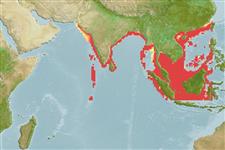Malacostraca |
Decapoda |
Penaeidae
Environment: milieu / climate zone / djupintervall / distribution range
Ekologi
; brackvatten; djupintervall 0 - 200 m (Ref. 356). Tropical, preferred 28°C (Ref. 107945); 27°N - 6°S, 65°E - 121°E
Indo-West Pacific: from Pakistan to Taiwan and Indonesia.
Length at first maturity / Size / Weight / Age
Könsmognad: Lm ? range ? - ? cm Max length : 19.0 cm TL hane/ej könsbestämd; (Ref. 356); 21.2 cm TL (female)
Maximum TL: 16.3 cm (male); 21.2 cm (female). Maximum carapace length: 3.1 cm (male); 3.3 cm (female) (Ref. 8). Vulnerability for synonym Fenneropenaeus penicillatus is 50. Juveniles inhabit mangrove inlets (Refs. 114627, 121464), intertidal mud flats and far inshore waters (Ref. 121464). In general, the majority of penaeids are omnivorous or detritus feeders (Ref. 105082).
Life cycle and mating behavior
Könsmognad | Reproduktion | Lek | Eggs | Fecundity | Larvae
Members of the order Decapoda are mostly gonochoric. Mating behavior: Precopulatory courtship ritual is common (through olfactory and tactile cues); usually indirect sperm transfer.
SAUP Database 2006 SAUP Database. www.seaaroundus.org. (Ref. 356)
IUCN Red List Status
(Ref. 130435: Version 2025-1)
CITES status (Ref. 108899)
Not Evaluated
Not Evaluated
Threat to humans
Human uses
Fiskeri: kommersiell
FAO - Vattenbruk: production; fiskeri: landings | FishSource | Sea Around Us
Verktyg
Ytterligare information
Trophic EcologyFood items (preys)
Födosammansättning
Födointag
Predatorer
PhysiologySyreförbrukning
Human RelatedStamps, coins, misc.
Internet-källor
Estimates based on models
Preferred temperature
(Ref.
115969): 20.4 - 26.1, mean 23.6 (based on 156 cells).
Fishing Vulnerability
Low vulnerability (11 of 100).
Climate Vulnerability
Moderate to high vulnerability (48 of 100).
Nutrients : Calcium = 109 [35, 184] mg/100g; Iron = 1.59 [1.21, 1.97] mg/100g; Protein = 20.2 [19.2, 21.3] %; Omega3 = 0.285 [0.185, 0.386] g/100g; Selenium = 48.3 [-31.7, 128.3] μg/100g; VitaminA = 0 μg/100g; Zinc = 1.79 [1.17, 2.40] mg/100g (wet weight); based on
nutrient studies.
